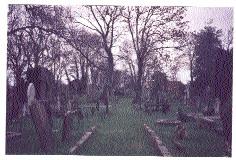Friar’s Bush cemetery
Published in 18th-19th Century Social Perspectives, 18th–19th - Century History, Issue 4 (Winter 2004), News, Volume 12 The Friar’s Bush cemetery on Stranmillis Road, Belfast, may only be two acres in size, but its history is far grislier than you might expect—plague, body-snatching, famine and murder are all part of its story. The gates have been closed since 1869 and only family members can get in—to be buried—but aside from the graves of noted locals such as Bernard Hughes, the rags-to-riches entrepreneur and inventor of the large, flour-covered roll called the ‘Belfast bap’, there is something ominous as soon as you pass through the gate lodge. Covered in exotic herbs and grasses alien to the country, the mound is known as the ‘plaguey pit’ and marks the resting-place of thousands of people who perished in a major cholera epidemic in 1832–3, when bodies—most of them unidentified—were burnt to prevent the spread of infection. It was opened again in 1847 to take victims of the Great Famine, and by 1852 it was declared to be ‘excessively overcrowded’ and closed soon after.
The Friar’s Bush cemetery on Stranmillis Road, Belfast, may only be two acres in size, but its history is far grislier than you might expect—plague, body-snatching, famine and murder are all part of its story. The gates have been closed since 1869 and only family members can get in—to be buried—but aside from the graves of noted locals such as Bernard Hughes, the rags-to-riches entrepreneur and inventor of the large, flour-covered roll called the ‘Belfast bap’, there is something ominous as soon as you pass through the gate lodge. Covered in exotic herbs and grasses alien to the country, the mound is known as the ‘plaguey pit’ and marks the resting-place of thousands of people who perished in a major cholera epidemic in 1832–3, when bodies—most of them unidentified—were burnt to prevent the spread of infection. It was opened again in 1847 to take victims of the Great Famine, and by 1852 it was declared to be ‘excessively overcrowded’ and closed soon after.
There are other anonymous dead here too; the cemetery is in the affluent Malone district of the city, and in years past there were many tragic stories of servant girls, maids and even mistresses who, petrified of scandal and illegitimacy, threw their babies—alive and dead—over the wall. The gatekeeper and gravediggers made more than a few gruesome discoveries at dawn.
Before that, the cemetery had some illegal assistance in emptying graves. The most famous body-snatchers or ‘resurrection men’ were Burke and Hare—both from Ulster—but in 1823 two men called Stewart and Feeny were caught at the docks with the bodies of a middle-aged female and a child, both recently buried at Friar’s Bush but now squeezed into a barrel and packed tight with sawdust. They had risked the often-treacherous journey across from Scotland, where medical schools at Edinburgh and Glasgow were starved of corpses to dissect because the only cadavers permitted were those of hanged criminals. It was a trade that continued until 1832, when the law was finally changed.
Going even further back, the cemetery’s prominent twisted thorn bush gave the site its distinct name. The eighteenth-century Penal Laws outlawed the celebration of the Catholic Mass, and while these laws were not always fully enforced, there are many stories of brave men crossing the River Lagan to lead services for the faithful. It was at one of these services that a friar was murdered—some say by a shot to the heart, others by being captured and hung from the very tree he had been preaching under. The nearby ‘Friar’s Stone’ marks his resting-place.
Even in modern times, Friar’s Bush had the power to scare people away; when plans were drafted to widen the road, they were swiftly quashed when it was rumoured that disturbing the plaguey pit might release something other than spirits back into the city.
James Bartlett is a local historian.
















